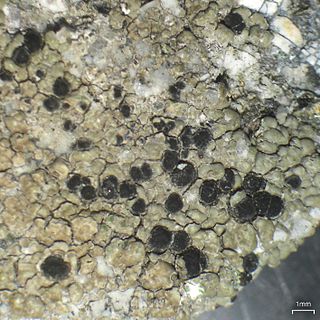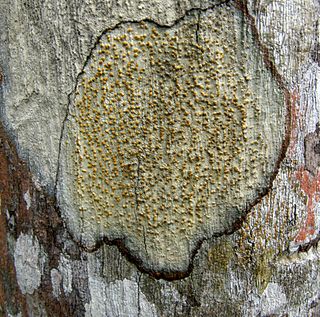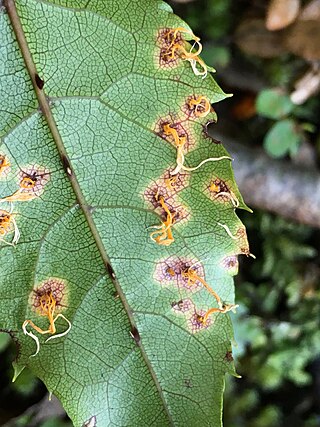Related Research Articles

Panaeolus is a genus of small, black-spored, saprotrophic agarics. The word Panaeolus is Greek for "all variegated", alluding to the spotted gills of the mushrooms produced.

Agaricomycetidae is a subclass of fungi, in the division Basidiomycota. The name Agaricomycetidae had previously been named by Marcel Locquin in 1984, but his publication did not contain a Latin diagnosis and it is therefore invalid under the International Code of Nomenclature for algae, fungi, and plants. It was subsequently validly published by Erast Parmasto in 1986.
MycoBank is an online database, documenting new mycological names and combinations, eventually combined with descriptions and illustrations. It is run by the Westerdijk Fungal Biodiversity Institute in Utrecht.

Physcia is a genus of lichenized fungi in the family Physciaceae. The genus name means "inflated" or "sausage-like", referring to the form of the type species. According to a 2008 estimate, the widespread genus contains 73 species.

Ombrophila is a genus of fungi in the family Helotiaceae. The genus contains 11 species. Elias Fries circumscribed Ombrophila in 1849.
Eremothecella is a genus of lichenized fungi in the family Arthoniaceae. The genus is widespread in tropical areas, and contains six species.

Nephromopsis is a genus of lichenized fungi within the Parmeliaceae family.
Dubitatio is a fungal genus in the family Massariaceae. According to the 2007 Outline of Ascomycota, the placement of the genus in this family is uncertain. This is a monotypic genus, containing the single species Dubitatio dubitationum, found in temperate South America.

Polyozellus is a fungal genus in the family Thelephoraceae, a grouping of mushrooms known collectively as the leathery earthfans. Previously considered a monotypic genus, it now contains the Polyozellus multiplex species complex. The genus name is derived from the Greek poly meaning many, and oz, meaning branch. It is commonly known as the blue chanterelle, the clustered blue chanterelle, or, in Alaska, the black chanterelle. The distinctive fruit body of this species comprises blue- to purple-colored clusters of vase- or spoon-shaped caps with veiny wrinkles on the undersurface that run down the length of the stem.
Merodontis is a fungal genus in the order Helotiales. The relationship of this taxon to other taxa within the order is unknown, and it has not yet been placed with certainty into any family. This is a monotypic genus, containing the single species Merodontis tenella. Merodontis was circumscribed by American ecologist Frederic Clements in 1909.

Lecidea is a genus of crustose lichens with a carbon black ring or outer margin (exciple) around the fruiting body disc (apothecium), usually found growing on (saxicolous) or in (endolithic) rock. Lichens that have such a black exciple are called lecideine, meaning "like Lecidea, even if they are not in this genus. Members of the genus are commonly called disk lichens or tile lichens.
Palaeocephala is a genus of fungi. This is a monotypic genus, containing the single species Palaeocephala cymatelloides, described by Rolf Singer in 1962. According to the Dictionary of the Fungi, the genus is classified in either the Marasmiaceae or Physalacriaceae families; the taxonomical database MycoBank includes it in the Marasmiaceae.

Trypethelium is a genus of lichenized fungi in the family Trypetheliaceae. The widespread genus contains about 50 species that are predominantly found in tropical areas. Trypethelium was circumscribed by German botanist Kurt Polycarp Joachim Sprengel in 1804.
Sphaceloma is a genus of ascomycete fungi. Its species are plant pathogens, and cause anthracnose and scab diseases. The widespread genus is estimated to contain 52 species.
The Pucciniosiraceae are a family of rust fungi in the order Pucciniales. The family contains 10 genera and 57 species.

Hamaspora is a genus of rust fungi in the family Phragmidiaceae. The genus contains 14 species, which are known from Africa, Asia, and Australia.
Trachyspora is a genus of rust fungi in the family Phragmidiaceae. The genus, widespread in northern temperate areas, contains six species.
Odontura is a fungal genus in the family Odontotremataceae. It is a monotypic genus, containing the single species Odontura rhaphidospora.
Pucciniosira is a genus of rust fungi belonging to the family Pucciniosiraceae.
References
- ↑ "Morispora tenella (H.S. Jacks. & Holw.) Salazar-Yepes, Pardo-Card. & Buriticá 2007". MycoBank. International Mycological Association. Retrieved 2011-07-10.
- ↑ Kirk PM, Cannon PF, Minter DW, Stalpers JA (2008). Dictionary of the Fungi (10th ed.). Wallingford, UK: CABI. ISBN 978-0-85199-826-8.
- ↑ Salazar-Yepes M, Pardo-Cardona V, Buriticá F (2007). "Especies de Colombia, Ecuador y Perú pertenecientes al género Gerwasia raciborski del orden Uredinales". Caldasia (in Spanish). 29 (1): 105–20.